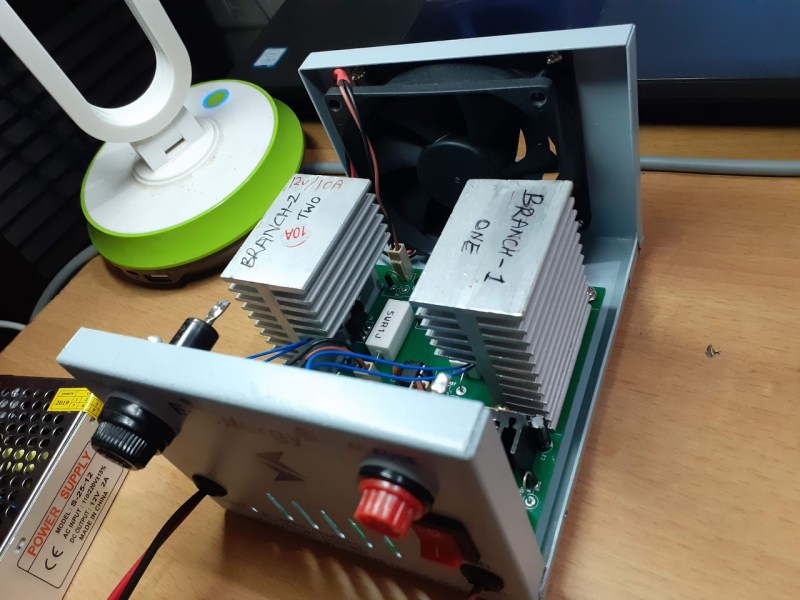While it might seem counterintuitive on the surface, there are a number of cases where dumping a large amount of energy into a resistor simply to turn it into heat is necessary to the operation of a circuit. Most of these cases involve testing electronic equipment such as power supplies or radio transmitters and while a simple resistor bank can be used in some situations, this active dummy load is comprised of different internals has some extra features to boot.
The load bank built by [Debraj] is actually an electronic load, which opens it up for a wider set of use cases than a simple passive dummy load like a resistor bank. It’s specifically designed for DC and also includes voltage measurement, current control, and temperature measurement and speed control of the fans on the heat sinks. It also includes a Bluetooth module that allows it to communicate to a computer using python via a custom protocol and GUI.
While this one does use a case and some other parts from another product and was specifically built to use them, the PCB schematics and code are all available to build your own or expand on this design. It’s intended for DC applications, but there are other dummy loads available for things such radio antenna design, and it turns out that you can learn a lot from them too.
















I like these chonky heatsinks. Does anyone know a part number for them, or something similar that can be mounted on a PCB with TO-220 / TO-218
I’ve only seen heatsinks like that in high wattage PC power supplies and server PSU’s.
Broken UPS devices with 1500VA or more are also good source of beefy heatsinks. Those with 3000VA are guaranteed to have bulky aluminium heatsinks that are easily reusable in DIY projects.
Aavid produces some under the name Max clip heatsinks:
https://www.boydcorp.com/thermal/air-cooling/max-clip-system.html
That looks like the heatsink for a SSR. I wouldn’t mount that on a PC board without additional support. Too heavy. Also, fins should be vertical for convection cooling. You can buy heatsink extrusion around 4″ wide for about 20 bucks a foot from lots of vendors. Cut it however long you want. That’s the least expensive for heavy duty heatsinks. The biggest board-mounted TO220 heatsinks are around 2×3 inches and meant for maybe 10 or 15 Watts.
As this design has a fan in the other orientation vertical fins would make the cooling worse not better… Its a valid design point that perhaps you can get by without a fan on just convection with the right orientation, and you can sometimes use it to help get better airflow.
While I agree on the weight of those heatsink being a concern it looks like its spreading its weight well over a large footprint area, and with nearby supports for the board straight to the chassis, so unless you are trying to make it Milspec/Toughbook level of impact resistant it should be fine, all its got to do is sit on a desk… Which will be enough for many uses cases.
My source of massive heatsinks is usually dead PC and their powersupply. But its also worth thinking about if just a flat bar/sheet of AL can be used in your project to sink the heat and as part of the outer shell, core structure etc – if you design around using a large sheet of Al as much as a structural element as a heatsink you can get good cooling for ‘free’… Great for anything that isn’t trying to dissipate hundreds of watts from a tiny spot (In that case you either really need some fins, active airflow or to have something aiding in the thermal transfers to the further edges of the sheet, like a heat pipe).
I bought a substantial stick of extrusion some time ago and I just chop what length I need and rip to width. Then I get the size I want/need rather than living with some stock size. It helps to have a machine shop. With sheet metal you have to be careful about flatness, especially if you make bends. Even with extrusions I generally mill the mounting area flat. Even a couple thousandths has a significant influence on heat transfer. If you’re talking about a Watt, fine. If you want to pull 100 Watts out of a TO220 it needs to be flat. A big chunk of metal doesn’t help if the heat doesn’t get in there.
Right you are, though you can hand sand and lap flat rough bar stock easy enough, a machine shop will be much easier and let you do more with it though (even a very modest small mill can do alot). Then if you mount the heat generating device to the stock with some spring washers/foam etc so it self levels to your ‘flat’ surface it will correct for any lack of squareness for you.
As I’m too cheap to buy in new for that one off project if I have something else I can reuse I will stick with old PC parts and raw stock for the most part… It’s what I have… Though no doubt I’ll need a big stock of identical heat sinks someday, and will then use that.
Me too! I’ve used aluminum L bracket for small heatsinks a bunch.
A couple winters ago, I built an LED plant-overwinterer out of 2020 style extrusions, and heatsiniked them from straight to the frame. You could feel the heat gradient in the 1 m sections.
A cut up soda can will also work for very low wattages. Sand off the plastic coating.
It looks like a CR series heatsink from Ohmite. You can get them for relatively inexpensive on Digi-key.
Representative product: https://www.digikey.com/en/products/detail/ohmite/CR101-50VE/7567947
My senior design team used them in our project (a motor controller) https://github.com/HEEV/motor-controller-2018